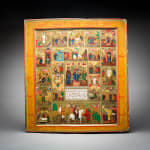Scenes from the Life of Christ, 19th Century CE
Tempera on Wood
10
PF.5975
Russians inherited the tradition of icon painting from Byzantium, where it began as an offshoot of the mosaic and fresco tradition. During the 8th and 9th centuries, the iconoclastic controversy...
Russians inherited the tradition of icon painting from Byzantium, where it began as an offshoot of the mosaic and fresco tradition. During the 8th and 9th centuries, the iconoclastic controversy in the Orthodox Church called into question whether religious images were a legitimate practice or sacrilegious idolatry. Although the use of images was in the end permitted, a thorough distinction between profane art intended to depict reality and sacred art designed for spiritual contemplation was established. Certain kinds of balance and harmony became established as reflections of divinity, and as such they invited careful reproduction and subtle refinement rather than striking novelty. Although this philosophy resulted in a comparatively slow evolution of style, icon painting evolved considerably over the centuries. Unlike the pictorial traditions of the west that aspire towards increased realism and naturalism, the essence of Russian icon painting is not about the representation of physical space or appearance. Icons are images intended to aid in contemplative prayer, and in that sense, are more concerned with conveying meditative harmony than with laying out a realistic scene. They were not painted to please the eye of the mind, but to inspire reflection and self-examination.
The central panel of this striking icon depicts Christ enthroned flanked by Mary and St. John. All these figures are repeated in the smaller surrounding panels that represent scenes from the life of Christ. The two most prominent of the smaller predella are the Flight into Egypt at the bottom and the Entry into Jerusalem directly above the central panel. The painter has masterfully arranged the composition so that the white horse and donkey from the two scenes echo each other. In the first, Christ is an infant who must flee his homeland for safety in Egypt. In the second, he returns triumphantly to the land of his birth riding along a donkey. These two events serve as effective bookends to the life of Christ. This icon depicts some of the most famous events from the life of Christ in order to remind the viewer of the path he undertook and the choices he made. Gazing upon this stunning painting, we are reminded that righteousness is a constant struggle that permeates every moment of our lives, and the life of Christ as well.
The central panel of this striking icon depicts Christ enthroned flanked by Mary and St. John. All these figures are repeated in the smaller surrounding panels that represent scenes from the life of Christ. The two most prominent of the smaller predella are the Flight into Egypt at the bottom and the Entry into Jerusalem directly above the central panel. The painter has masterfully arranged the composition so that the white horse and donkey from the two scenes echo each other. In the first, Christ is an infant who must flee his homeland for safety in Egypt. In the second, he returns triumphantly to the land of his birth riding along a donkey. These two events serve as effective bookends to the life of Christ. This icon depicts some of the most famous events from the life of Christ in order to remind the viewer of the path he undertook and the choices he made. Gazing upon this stunning painting, we are reminded that righteousness is a constant struggle that permeates every moment of our lives, and the life of Christ as well.



